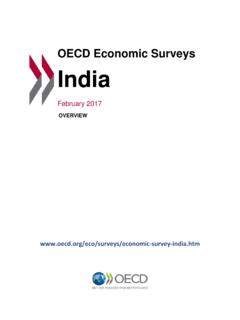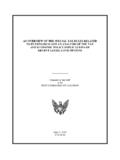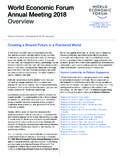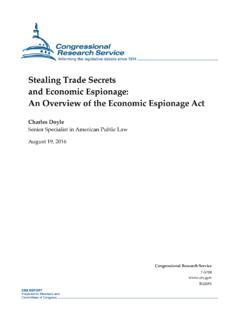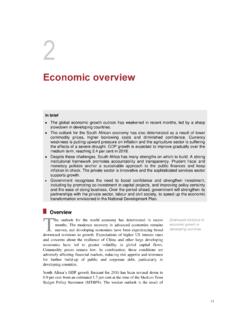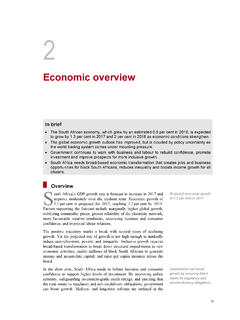Transcription of OECD Economic Surveys Australia
1 OECD Economic Surveys Australia March 2017 overview This overview is extracted from the 2017 Economic Survey of Australia . The Survey is published on the responsibility of the Economic and Development Review Committee (EDRC) of the OECD, which is charged with the examination of the Economic situation of member countries. This document and any map included herein are without prejudice to the status of or sovereignty over any territory, to the delimitation of international frontiers and boundaries and to the name of any territory, city or area OECD Economic Surveys : Australia OECD 2017 You can copy, download or print OECD content for your own use, and you can include excerpts from OECD publications, databases and multimedia products in your own documents, presentations, blogs, websites and teaching materials, provided that suitable acknowledgment of OECD as source and copyright owner is given.
2 All requests for public or commercial use and translation rights should be submitted to Requests for permission to photocopy portions of this material for public or commercial use shall be addressed directly to the Copyright Clearance Center (CCC) at or the Centre fran ais d exploitation du droit de copie (CFC) at OECD Economic Surveys : Australia OECD 2017 Executive summary Supporting rebalancing with macroeconomic policies Sustaining growth by bolstering the environment for business innovation Addressing inequality and ensuring Economic rebalancing delivers more inclusivegrowth1 EXECUTIVE SUMMARYOECD Economic Surveys : Australia OECD 2017 Supporting rebalancing with macroeconomic policiesCommodity prices and GDP growthSource:OECD ADB; 2 s economy has enjoyed considerablesuccess in recent decades, reflecting strongmacroeconomic policy, structural reform and the longcommodity boom.
3 Living standards and well-being aregenerally high, though challenges remain in gendergaps and in greenhouse-gas emissions, and furtherchallenges arise from population ageing. The economyis now rebalancing following the end of the commodityboom, supported by macroeconomic policies andcurrency depreciation. The strengthening non-miningsector is projected to support output growth ofaround 3% in 2018 and spur further reduction in theunemployment rate. Low interest rates have supportedaggregate demand but are also ramping up risk-takingby investors and driving house prices and mortgagelending to historical growth by bolstering the environment for business innovationR&D spending as a share of GDPS ource:OECD MSTI 2 competition and other frameworkconditions that influence the absorption anddevelopment of innovation are key for restoringproductivity growth. Innovation requires labour andcapital markets that facilitate new business growth could be boosted throughstronger collaboration between business andresearch sectors in R&D activity.
4 The government sreform programme, notably theNational Innovationand Science Agenda, is providing welcome impetus inequality and ensuring Economic rebalancing delivers more inclusivegrowthReal increase of household incomeand wealth, 2004-14 2 s adjustment to the end of thecommodity boom has not been has risen, and there are increasingconcerns about inequality. In addition, largesocioeconomic gaps between Australia 's indigenouscommunity and the rest of the population innovation-related skills will beimportant for the underprivileged and thosedisplaced by Economic restructuring, and can helpreduce gender wage prices (LHS)Annual average GDP growth (RHS)2000 Q1= wealth%Lowest quintile (poorest)Highest quintile (richest)2 EXECUTIVE SUMMARYOECD Economic Surveys : Australia OECD 2017 MAIN FINDINGSKEY RECOMMENDATIONSM acroeconomic and financial-market regulation policiesLow interest rates have fuelled high houseprices and generated substantialmortgage borrowingMaintain tight macro-prudential measuresFacilitate housing supply increases through improved planning regulationThere is fiscal space available to supportthe economy if requiredUse all policy levers to support the economy if downside risks materialise,relying more heavily on fiscal remains highly concentrated.
5 Potentially compromising competitionand making Australia vulnerable to toobig to fail risksReduce banks implicit guarantees by developing a loss absorbing andrecapitalisation frameworkFiscal reformGlobal commodity swings can have largebudgetary effectsConsider a spending ceiling to contain expenditure growth in booms andtargeting debt in the long termCreate stabilisation funds using resource revenues, or make greater use ofexisting funds, to insulate the budget from commodity price changesChange the tax mix to better supportgrowthFurther shift from corporate income taxes and inefficient taxes, raise theGoods and Services Tax and land taxesMake the R&D Tax Incentive more effective, for instance by combining aneligibility threshold with an increase in the expenditure capMaintaining quality public services givenlow growth in public expenditure is achallengeEncourage more innovation in public services by opening up procurementto more bidders and further development of digital government servicesReduce the number of support schemes for innovative SMEsBoosting productivity through a more innovation-friendly business environmentBusiness framework conditions couldbetter support the absorption and creationof innovation through strongercompetition and resource allocationImprove competition law, notably by strengthening the definition of abuseof dominant positionAdjust insolvency legislationIncrease labour mobility, for instance by lower interstate differences ineducation and training programmesEncourage market entry by innovative business.
6 Use competition policytools to combat resistance by incumbents and adjust sectoral regulationquickly as new firms and industries emergeFacilitate the entry of a fourth operator in mobile telephony via a spectrumauctionResearch-business collaboration is weakand decision making in the innovationsystem fragmentedPut a greater weight, as envisaged, on collaboration in university fundingand develop a more coordinated approach to industry placements forresearch students to strengthen the linkages between research andbusiness sectorsImplement the common approach across public-sector researchorganisations for assessing research outcomes and impactsDevelop a more integrated, whole-of-government approach to science,research and innovation and consolidate innovation support programmesHelping output growth and inclusiveness, deepening skillsInclusiveness is being erodedAvoid freezing welfare pay outs as part of fiscal restraint so as to notcompromise inclusivenessContinue developing an investment approach to welfare policy thatfocuses on vulnerable groups where the returns to policy are greatestSkills for innovation are weakWiden the scope of subsidies for innovation-related subjects beyond STEM( innovation-related arts disciplines)Environmental sustainabilityNew greenhouse-gas reduction targetshave been setStrengthen the recently introduced safeguard mechanism should theEmissions Reduction Fund require additional support to achievegreenhouse-gas reduction3 OECD Economic Surveys : Australia OECD 2017 Assessment and recommendations Macroeconomic developments and near-term prospects: post-boom adjustmentcontinues Monetary and financial-market policy.
7 Coping with low interest rates Fiscal consolidation, tax and spending reform Encouraging business productivity and innovation through framework conditions Encouraging productivity and innovation through R&D policy Addressing inequality, enhancing inclusiveness and deepening skills Tackling environmental challenges: progress in greenhouse-gas emission policyThe statistical data for Israel are supplied by and under the responsibility of the relevant Israeliauthorities. The use of such data by the OECD is without prejudice to the status of the Golan Heights,East Jerusalem and Israeli settlements in the West Bank under the terms of international AND RECOMMENDATIONSOECD Economic Surveys : Australia OECD 2017 Following an impressive 25 consecutive years of output growth, Australia s grossdomestic product per capita is high and the country generally ranks favourably in well-being (Figure 1).
8 Despite the end of the global commodity super-cycle, the economycontinues to perform well. The rebalancing of Economic activity from commodityinvestment to other activities is well advanced, facilitated by monetary and fiscal policies,currency depreciation, and flexible labour and product , Australia s economy shares the global risk of a low-growth trap . Along withmany OECD countries, productivity growth has slowed since its peak in the 1990s (Figure 2)but remains in line with its longer term average. Despite encouraging recent productivitygrowth, population aging (the number of Australians over 65 years of age will more thandouble by 2055) means the country s growth prospects depend crucially on strongproductivity growth which, in turn, requires greater capacity for absorbing and generatingnew innovations. This is the subject of thisSurvey s in-depth examination of innovationand related policies and the focus of a recent government initiative (theNational Innovationand Science Agenda; Australian Government, 2015a).
9 Furthermore, inclusiveness has been eroded. The Gini coefficient has been drifting upand households in upper income brackets have benefited disproportionally fromAustralia s long period of Economic growth. Real incomes for the top quintile of householdsgrew by more than 40% between 2004 and 2014 while those for the lowest quintile onlygrew by about 25% (Figure 3). Strong growth has pulled the incomes of households withwage earners further ahead of households reliant on transfers or pensions, whichdominate the lower end of the income distribution. Furthermore, recent economicdevelopment has been strongly skill biased partly because scale effects have amplifiedreturns to some already high-paid segments of the labour market widening the wagedistribution. This partly explains the increasing share of income going to the very top endof the income distribution. In addition, large socioeconomic gaps between Australia sindigenous population (Box 1) and the rest of the population remain and there is room toreduce gender imbalance (Figures 3 and 4).
10 Against this background the main messages of thisSurveyare: Strong macroeconomic and financial-sector institutions and policies have supportedstrong Economic growth and high living standards. Merely maintaining long-run average productivity growth jeopardises this success; arenewed emphasis on structural reforms in particular those that help boost Australia scapacity to absorb and generate innovation is required. Widening income inequalities and longstanding issues of inclusion (notably Australia sindigenous population) call for an ongoing emphasis on policies to ensure equitableopportunities for engaging in the labour market through skills acquisition and activelabour market policies, especially policies that address these concerns while alsoenhancing AND RECOMMENDATIONSOECD Economic Surveys : Australia OECD 2017 Figure per capita is high and well-being indicators compare favourably1.











